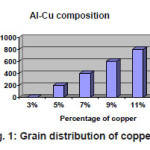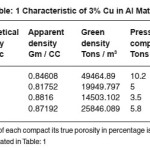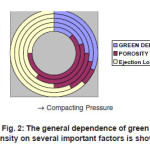K. Raji1 and S. Alfred Cecil Raj2
1Department of Physics, Holy Cross College (Auto), Tiruchirappalli, India.
2Department of Physics, St. Joseph's College (Auto), Tiruchirappalli, India.
Corresponding Author E-mail: rajdavey59@yahoo.co.in
DOI : http://dx.doi.org/10.13005/msri/070221
Article Publishing History
Article Received on : 20 Jul 2010
Article Accepted on : 07 Sep 2010
Article Published :
Plagiarism Check: No
Article Metrics
ABSTRACT:
This paper gives a vivid picture about Aluminium matrix composite. P/M aluminium and aluminium matrix composites offer lower density, improved strength, stiffness, and wear resistance. The materials are produced from both blended elemental powders and pre alloyed powders with additives by a range of processing routes such as sintering, compression and annealing. The purpose of the investigation is to study the characteristics of selected Al-Cu composition. Because aluminium is silvery–white in colour and extensively used where a light non corrosive metal is desired as an aircraft and automobile components where the saving of weight is an added advantage and moreover Aluminium finds its widest use when alloyed with small amount of other metals.
KEYWORDS:
Green density; Compacting; Ejection; Porosity
Copy the following to cite this article:
Raji K, Raj S. A. C. Analysis of Aluminium Matrix Composite Using Oxidised Copper. Mat.Sci.Res.India;7(2)
|
Introduction
The traditional powder metallurgy has seen tremendous developments over the years since the major industrial scale applications initiated with the production of self–lubricant bearings and cemented carbides. The continuous and sustaining research and development over the years have contributed several innovations in this process. The trends in globalization, world trade and industrial acquisition and alliance have their own impact on P/M industry. Automotive industry is the major customer of P/M accounting for about 60 to 80 percent of its total production.
Experimental
Evaluation of Grain Size
In order to evaluate the grain size of the particle, sieve analysis method1 is used. This method is used to separate different grain size particles and also to determine the grain size of the Al-Cu composite where 9% copper in weight proportion is added to aluminium.The sieve shaker consists of standard set of sieves, having apertures of different sizes arranged one over the other in decreasing order with coarsest sieve on the top. The powder composition collected is weighed and placed on the top sieve and the sieve shaker is shaken for 30 minutes. The grain size distribution of Cu is shown in the form of histogram in Fig. 1.
Figure 1: Grain distribution of copper
Preparation of Compacts
The experimental set up for preparation of compacts consisting dies, punch, lower punch support and ejection block. Lower punch support is placed at the bottom of the die to support the loose powder poured in the cylinder. Molybdenum die sulphide is used for die wall lubrication in order to get the finished compact2 from the die wall easily. Ejection block is used to eject the finished component from the die wall without any damage. A universal testing machine is used for compaction of the AL-CU composition by single action die compaction.
Characteristics of Compacts
Nearly 15 compacts are prepared for the test. The green compact obtained is weighed using a common balance. Length and diameter of the green compact is measured with a micrometer. Green density3 is calculated using the equation G=4W / (II d 2g Ig) and it is tabulated. The parameters like apparent density, theoretical density, true porosity and hardness are calculated and recorded calculated using the equation (1) and the values are tabulated in Table 1.
Percentage of True porosity 4=1-(Green Density/True Density) …(1)
Table: 1 Characteristic of 3% Cu in Al Matrix
Results
The green density is increasing with increase in compacting pressure5 and increase in Particle size (Fig. 2)
The Porosity is decreasing6 with increase in compacting pressure (Fig. 2)
Ejection load and green hardness are increasing7 with the increase in compacting Pressure (Fig. 2)
Figure 2: The general dependence of green density on several important factors is shown
Discussion
The most common internal defect is porosity. This generally arises from shrinkage during solidification and in this case the order of porosity is minimized. The metal powders obtained in a suitable degree of fineness and purity is also the main cause for the best result. The metal powder composite is subjected to a sufficient pressure in a suitable mould to cause cohesion to occur between the particles and there by increasing the density of the compact. The increase in the hardness of the composite may be giving the ability to resist being permanently deformed when a load is applied.
Conclusion
It is understood that, the greater the hardness, the greater is the resistance towards deformation because it consists of the fine dispersion of Alumina8 (Al2O3) particles into a polycrystalline aluminum matrix. The presence of this second phase gives it interesting mechanical properties. The present investigation showed that it is possible to make powder metallurgy components from different composition of Al -Cu. While growth is expected to accelerate, it is important to track of changes in automotive industry as they are the major users of structural PM parts.
Acknowledgements
The author thanks the UGC funding agency and Professors of Holy Cross College and St. Joseph’s College.
References
- Lin CB , Chang,R.J.,Weng,W.P. , A study on process and tribological behaviour of Al alloy/ Gr (p) composite, Wear. 217: 167-174 (1998).
- Lepper K., James M., Chashechkina., J.,Rigney, D.A., Sliding behaviour of selected aluminium alloys, Wear. 203: 46-56 (1997).
- Pathak, J. P., Torabian, H., Tiwari, S. N., Anti seizure and antifriction characteristics of Al-Si-Ph alloys, Wear 202: 134-141 (1997).
- G.S. Upadhyaya, Sintered Metallic and Ceramic Materials, J.Wiley, New York, NY, 21 (1999).
- Yihr A.A, Chung D.D.L, Titanium di boride Copper matrix composites, Journal of Material Science, 32: 1703-1709 (1997).
- V. Sivaraj, Engineering Metallurgy VK Publishers, Bangalore, India, 62 (1980)
- W.J Dawson, Hydrothermal Synthesis of Advanced Ceramic Powders Am. Cream. Soc. Bull., 67(10): 1673-1678 1998.
- R.M.Anklekar, K. Bauer, D.K. Agrawal and R.Roy, Improved mechanical properties and Microstructures development of microwave Sintered copper and nickel steel PM parts, Powder Metallurgy. 48(1) (2005).

This work is licensed under a Creative Commons Attribution 4.0 International License.
 Material Science Research India An International Peer Reviewed Research Journal
Material Science Research India An International Peer Reviewed Research Journal





